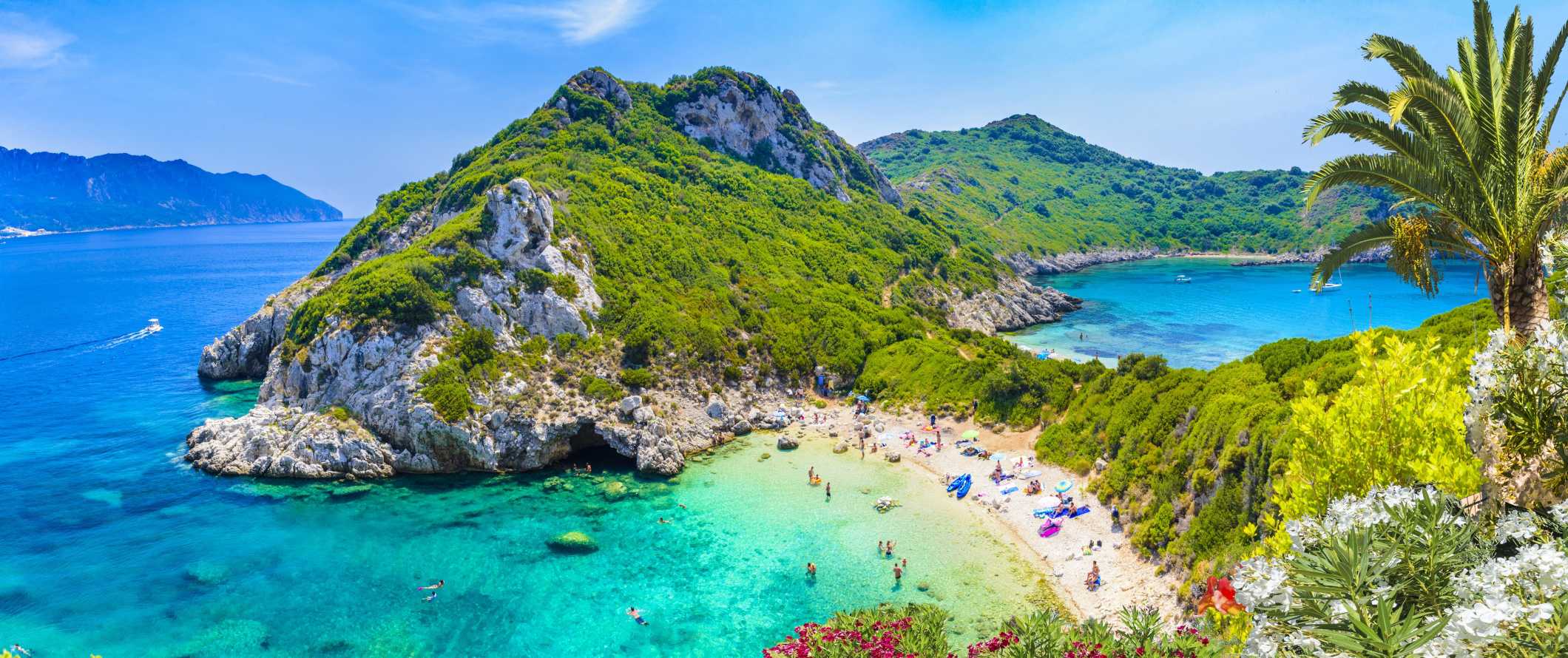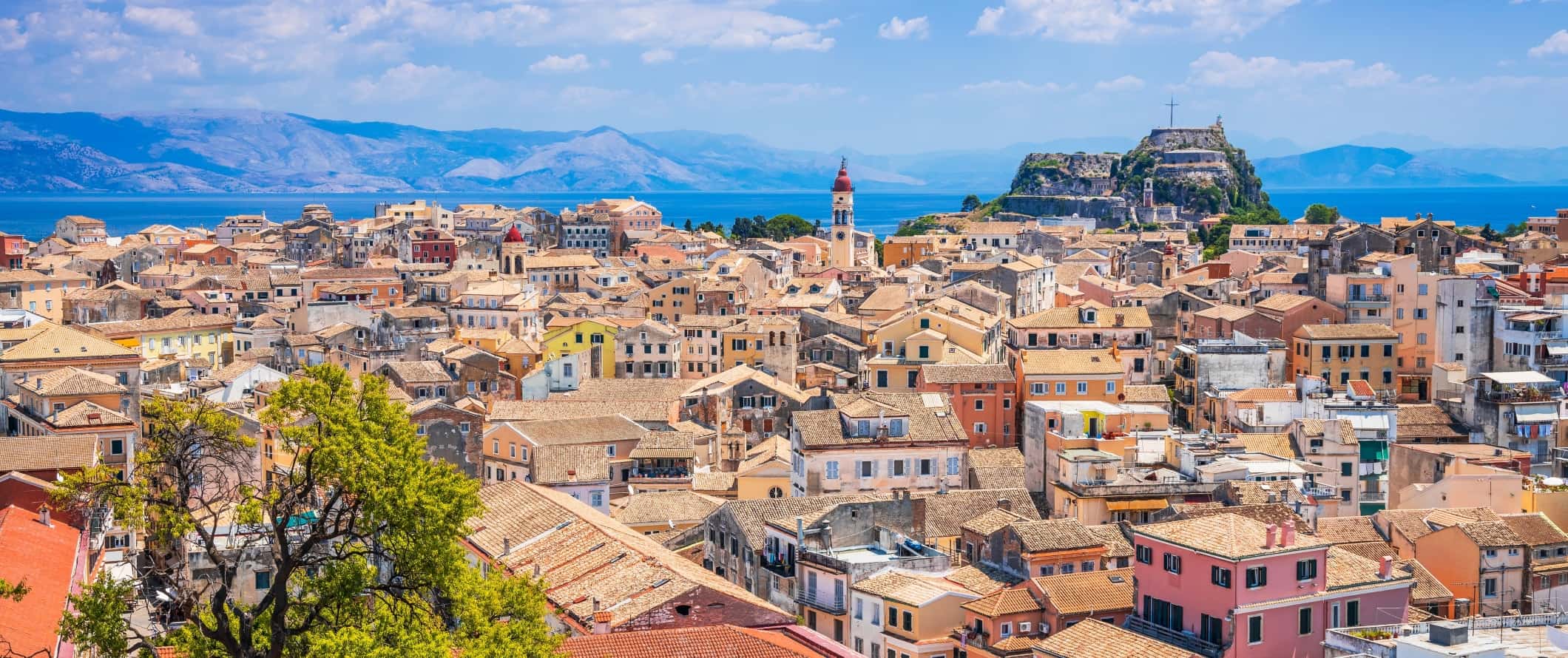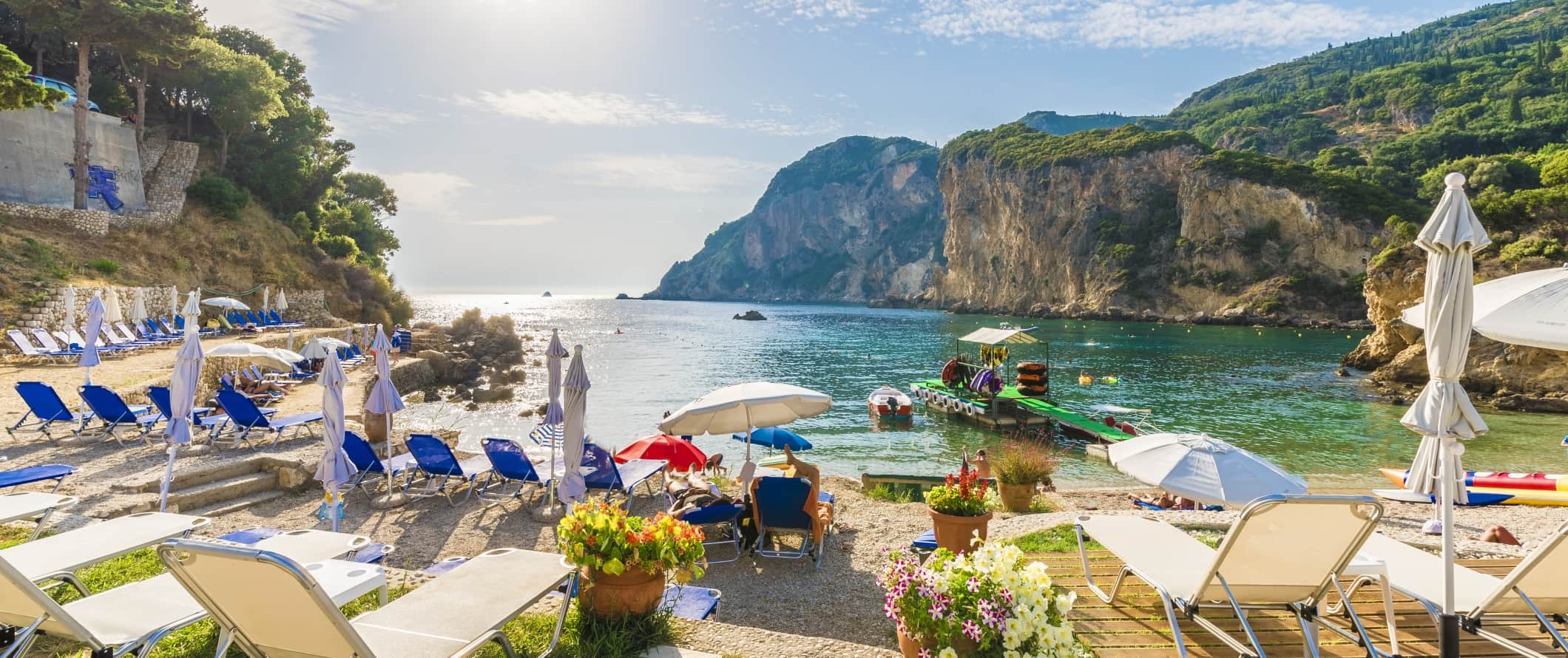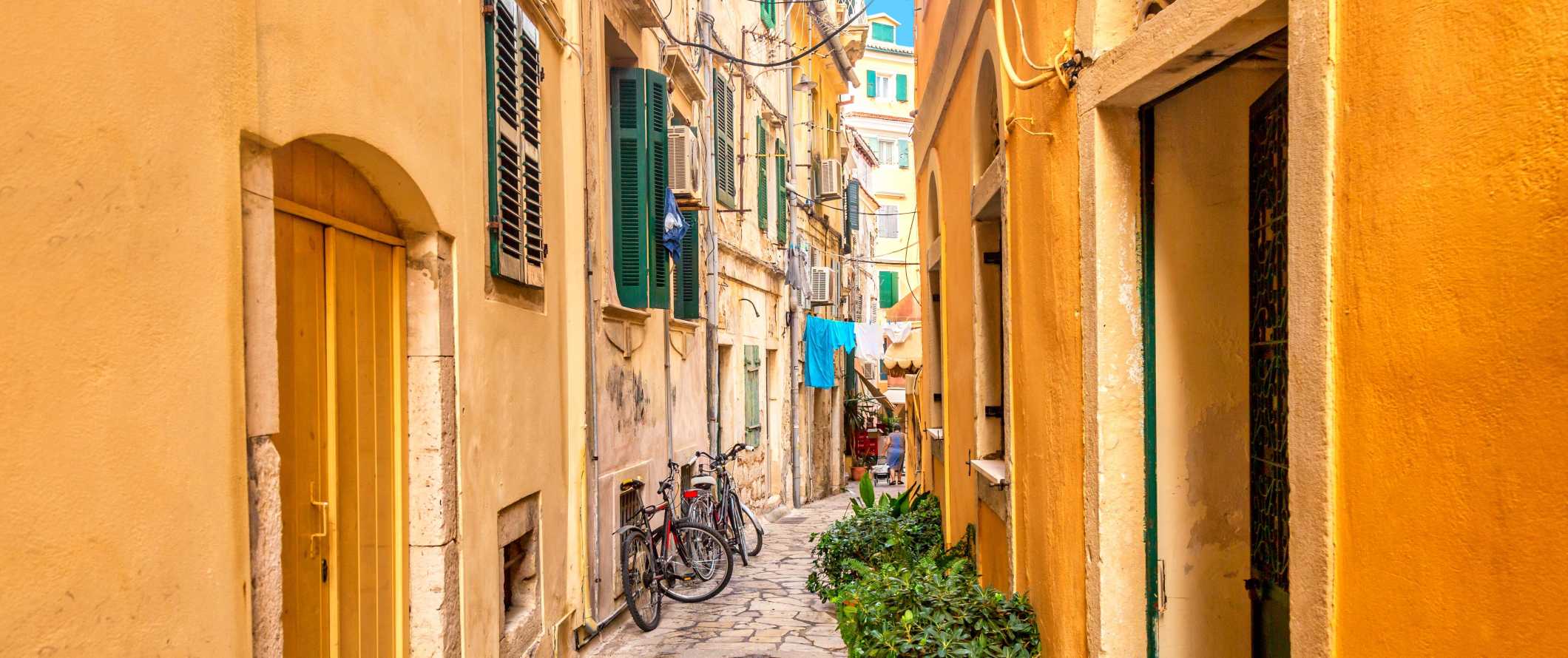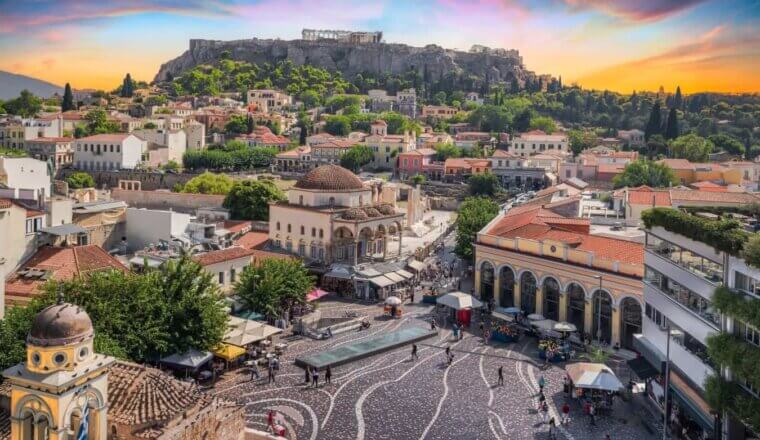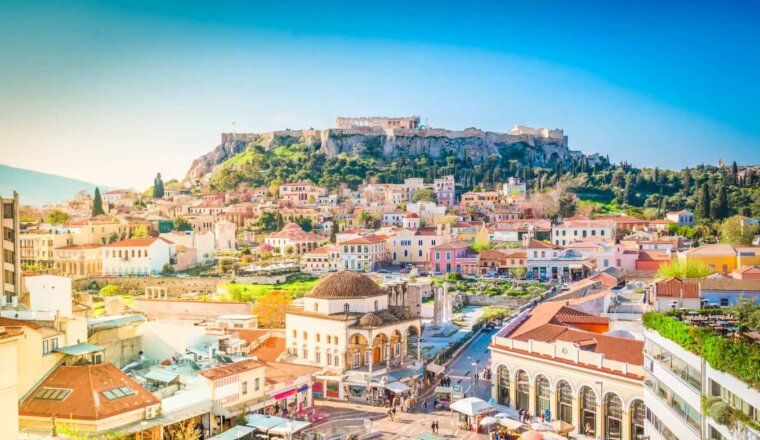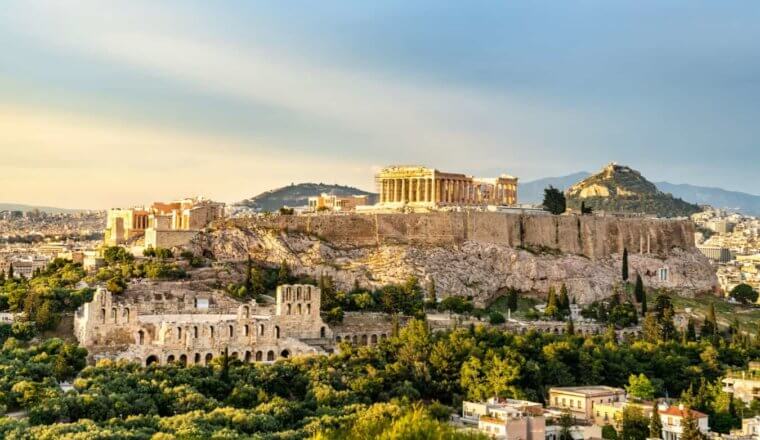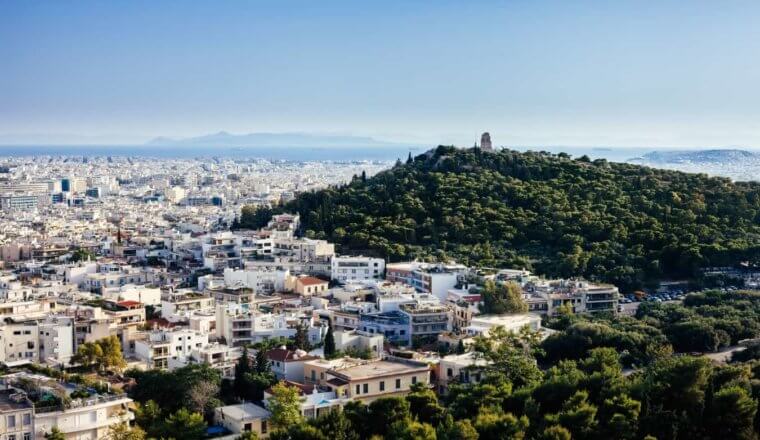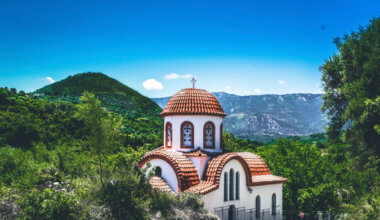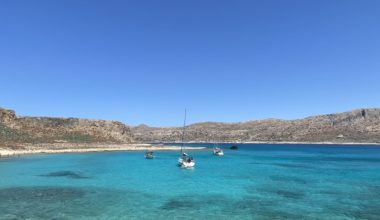Corfu has been one of Greece’s most popular islands since the 1970s. Located in the Ionian island group in western Greece, Corfu has beautiful white sand beaches, easy connections to Italy and Albania, stunning mountains, and wild, crazy nightlife.
While it gets crowded during the summer (especially with young backpackers), there are still many quiet places to stay and see on the island as most of the action sticks to just a few hotspots.
I love the atmosphere here. It is a lot more relaxed than other islands in the Mediterranean, and there’s a great intersection of cultures here.
This travel guide to Corfu can help you plan your trip so you save money and have the best experience possible — no matter why or when you go!
Table of Contents
Top 5 Things to See and Do in Corfu
1. Explore Kassiopi
Kassiopi is a small fishing village on the northern side of Corfu that’s much quieter than the popular Corfu Town (the main town on the island). From here, you can walk among the ruins of the Byzantine Kassiopi castle, lounge on the beach, or relax in the town square. You can also take a boat trip along the surrounding coastline to go diving, snorkeling, swimming, or just have lunch on a more remote beach. At night, grab dinner and drinks at one of the traditional restaurants along the picturesque waterfront.
2. See the Church of Saint Spyridon
This 16th-century Greek Orthodox church in the middle of Corfu’s Old Town is full of frescoes and elaborate artwork. You can’t miss it as the bell tower is the highest in the Ionian Islands. The church holds the remains of the island’s patron saint, Spyridon, a shepherd from the 4th century who is said to protect the island from all ills, including the Ottomans and even the plague. The silver casket containing his remains is paraded through town during special events.
3. Hit the beaches
Great beaches abound all over the island, with each area offering something different. The western side of Corfu is home to a long stretch of sandy beaches, the eastern side has calmer waters, and the northern beaches are mainly pebble beaches. Sidari has the sandiest beaches, while the deep, calm waters around Paleokastritsa are ideal for water skiing, boating, and parasailing. Agios Georgios South is good for diving.
4. Spend time in Paleokastritsa
Located just 23 kilometers (14 miles) from Corfu Town, this relaxing seaside town has calm beaches and clear turquoise waters that are perfect for swimming and snorkeling. You can visit nearby caves and hike up to the 13th-century Theotokos Monastery for views overlooking the town and the Mediterranean. End your day relaxing at the Greek tavernas serving fresh seafood on the waterfront.
5. Explore Achilleion
The Empress Elisabeth of Austria built this palace in 1890 as a place to seek summer refuge after the tragic death of her only son. It was designed in the style of an ancient palace of Phaeacia, a region in Greek mythology, and there are paintings and sculptures of Greek gods and goddesses throughout. The mythical hero Achilles is the central theme, and a sculpture of the Dying Achilles is the centerpiece of the gardens. The palace is located in Gastouri, a town only 10 kilometers (6 miles) from Corfu Town. Admission is 5 EUR.
Other Things to See and Do in Corfu
1. Hang out in Corfu Town
The origins of Corfu Town stretch all the way back to the 8th century BCE, when the town was an important commercial center for the Phoenicians. It used to be called Paleopolis, and you can see some of its original ruins opposite the Mon Repos Palace. Corfu was under Venetian rule between the 14th and 18th centuries, so there is a lot of Venetian architecture around town as well, such as pastel-colored buildings, iron fencing, cobblestone streets, and wooden shutters. It’s a nice place to stroll around and bask in the layers of history.
2. Check out Nymfes village
According to legend, Nymphs (nature deities from Greek folklore) used to bathe in 200-meter-high waterfalls near this village. Just north of town, you can visit the waterfalls and see the remains of nearby Askitario, a small, ancient monastery. A monk named Artemios Paissios lived here alone in the 5th century. He once had a premonition that his parents were coming to fetch him, so he dug a grave to lie down in it – at which point a boulder rolled on top of him. When his parents tried to dig him out, the boulder apparently ignited into flames. The village is 33 kilometers (20 miles) north of Corfu Town and takes just under an hour to get to by car.
3. Visit Aqualand
Aqualand is a fun, family-friendly waterpark with 15 different water-themed rides and attractions, including slides, pools, and rivers. It’s a little cheesy, but it gives you something different to do after you’ve spent a few days on the beach or browsing ruins (it’s especially fun if you’re with kids). Full-day access is 33 EUR (30 EUR if you book online), while two-day access is 55 EUR (50 EUR if you book online).
4. Hike the Corfu Trail
The Corfu Trail is an epic 150-kilometer (93-mile) trek starting from the south of the island and ending on the northern tip. It’s a fairly easy hike, with lots of signage as you weave your way through hills, mountains, lakes, lagoons, monasteries, and tiny towns. It’s a really unique way to experience Corfu away from the resorts, and there’s no shortage of accommodations along the way (or you can camp out). It’s broken up into 10 stages so most people do it over 10 days.
5. Go sailing
Thanks to the calm water and consistently warm weather, Corfu is an ideal place for sailing. Various companies offer charter trips, and many of them offer lunch packages and open bars. Some hostels run day-long party boats too. Day sails start from about 30 EUR per person.
6. Visit the Banknote Museum
Founded by the Ionian Bank, this coin museum in Corfu Town has exhibits showcasing coins, stamps, bank documents, post-Greek liberation banknotes, books, and foreign banknotes from the past two centuries. The highlight of the museum is a 100-billion-drachma note from 1944, the largest denomination note ever issued. Admission is free.
7. Take an olive oil tasting tour
Corfu covers a mere 585 square kilometers, yet it is home to over four million olive trees. Olive oil has always been a big part of Greek tradition and culture, and a tasting tour is a perfect way to learn about the production of this essential staple. Corfu Olive Tours offers an informative behind-the-scenes tour of olive tree groves and old mills where you can learn everything there is to know about olive oil. Plus, you get to try some samples too. A 1-hour tour is 15 EUR while the full 3-hour tour is 40 EUR.
8. Explore the Corfu Archaeological Museum
This museum is home to ancient artifacts from all over the island, including statues, funeral offerings, pottery, and golden jewelry. The most famous exhibit is the monumental pediment from the temple of Artemis, which depicts Gorgon, a monster of the underworld from Greek mythology. It’s the oldest stone pediment in Greece, dating to 590 BCE. Another highlight includes the stone lion of Menecrates and a limestone pediment from a temple to Dionysis. Admission is 6 EUR.
9. Visit Vlacherna Monastery
This picturesque, white-washed monastery on the eastern side of Corfu is set out on the water on its very own tiny island. You can only access it via a pedestrian bridge, which adds to its charm. As of 1980, it is no longer a monastery and functions today as a church for celebratory events, a tourist attraction, and even a filming location — most notably for the James Bond movie For Your Eyes Only. Being a former monastery, the interior is fairly simply decorated and the main draws here are the beautiful views of the building itself and the surrounding bay. Admission is free. You can also take a 5-minute (2.5 EUR) boat ride from the monastery to the nearby Mouse Island, a tiny, relaxed island with a 13th-century church and a cafe.
10. Admire the views from Angelokastro Castle
One of the most important Byzantine castles, Angelokastro is located high on steep cliffs along the water near Paleokastritsa. This 13th-century fortress successfully defended the island against its many invaders over the centuries, never falling despite many attacks and sieges. Today, the castle has deteriorated with the passage of time, and it’s mainly in ruins. However, the views from the top are absolutely spectacular. There are also other interesting features at the top, including an 18th-century hermitage, anthropomorphic graves carved out of the rock, and a tiny church dedicated to the Archangel Michael. Castle admission is 3 EUR.
For more information on other destinations in Greece, check out these guides:
Corfu Travel Costs
Hostel prices – A bed in a dorm with 4-8 beds costs 18-25 EUR per night (dorms with ten beds or more cost about the same price). Expect prices to drop by 2-3 EUR per night in the off-season. Private rooms star
t at 39 EUR per night and stay consistent throughout the year. Free Wi-Fi is standard, though self-catering facilities and free breakfast are not common.
For those traveling with a tent, a basic camping plot without electricity for one person starts at 12 EUR in the summer and 10.50 EUR in the off-season.
Budget hotel prices – A two-star hotel starts at 45 EUR per night anywhere on the island, although a beachfront property in Sidari costs 10-20 EUR more. In the off-season, you can find rooms for as little as 25 EUR per night.
Airbnb is available everywhere on Corfu, with private rooms costing at least 40 EUR per night. A full apartment averages about 130 EUR per night.
Food – Traditional Greek cuisine is very healthy, using a lot of fresh seasonal vegetables, olive oil, lamb, fish, pork, and cheeses (especially feta). Yogurts are also super common. Filo pastries stuffed with meat or spinach and cheese are a local favorite as are souvlaki and gyros.
You can find street food like gyros for under 5 EUR. A hearty pita or Greek salad costs around 7.5 EUR while a fast food combo costs around 8.50 EUR.
Pastitsada (slow-cooked rooster in a wine tomato sauce season with herbs and served over pasta) is Corfu’s signature dish. You can find it in most restaurants for around 10 EUR. Traditional veal dishes like psito and sofrito cost about 11 EUR. A beer to go with it costs 3 EUR.
At most restaurants, you can get an appetizer and an entrée for about 15 EUR. If you feel like splashing out, a meal at a higher-end restaurant can cost 40 EUR or more. A glass of local wine is another 4 EUR. If you’re looking to get fish, expect to spend between 20-30 EUR for your meal.
Most restaurants charge for bread. The price is between .50-1.50 EUR. A bottle of water is about 2 EUR, while a cappuccino or latter is 3 EUR.
If you cook for yourself, expect to spend around 45-50 EUR on groceries per week. This gets you basic staples like pasta, veggies, cheese, and some meat.
Backpacking Corfu Suggested Budgets
If you’re backpacking Corfu, expect to spend around 55 EUR per day. This assumes you’re staying in a hostel dorm, eating lots of cheap food, cooking some meals, using the bus to get around, visiting a few cheap attractions (like a museum) and taking advantage of free activities like beaches and hiking, and limiting your drinking. If you’re going to party while you’re here, add another 10-15 EUR per day to your budget.
On a mid-range budget of 115 EUR per day, you can stay in a private Airbnb or private hostel room, eat out for all your meals, rent a bike to get around, visit more museums and take some tours, and enjoy a few drinks. You won’t live large but you’ll want for nothing.
On a “luxury” budget of 215 EUR or more per day, you can stay in a hotel, eat out anywhere you want, drink as much as you’d like, take taxis or rent a car, and do as many tours and activities as you want. This is just the ground floor for luxury though. The sky is the limit!
One thing to keep in mind is that if you’re coming during peak summer, prices are about 10-20% higher for everything!
Corfu Travel Guide: Money-Saving Tips
Despite Corfu being one of the most touristy islands in Greece, the island remains relatively budget-friendly. Accommodation and tours will be your biggest expenses here but, overall, the island isn’t as expensive as places like Santorini or Mykonos.
Here are some of my favorite ways to cut your costs in Corfu:
- Get the Corfu City Pass – The Corfu City Pass gives you access to many different attractions under one price, including Aqualand, a day sail, a walking tour, and more. It can’t be purchased online so you’ll need to buy it on arrival.
- Use the Greek salad/bread rule – If the bread fee is .50 EUR or a Greek salad is less than 7 EUR, the restaurant is cheap. If the cover is around 1 EUR and a salad is 7-8.50 EUR, the prices are average. Anything more than that and the place is expensive. Use this rule to avoid expensive restaurants unless you want to splash out!
- Eat super cheap – Gyros and other street snacks only cost a few euros and can keep you full for less than 10 EUR per day if you’re on a tight budget.
- Have an ISIC Card – To save on the cost of admission to museums and other tourist attractions, be sure to present a valid student card if you’re a student. The ISIC is typically accepted in places where a foreign student ID is not.
- Book in advance – Corfu gets a lot of tourism and things tend to fill up quickly in the summer. If you want to secure that ultra-cheap hostel room, book way in advance!
- Travel in the shoulder season – Accommodations and scooter/ATV rentals are cheaper in the shoulder season. It may not be as hot as the summer months, but the weather is still pleasant.
- Book overnight ferries – Greece’s inter-island ferries can get quite expensive if you are taking a lot of them. Booking overnight ferries can save you up to half off the normal price plus save you a night of accommodation.
- Get a ferry pass – Eurail has a ferry pass that has 4- and 6-trip options. The only caveat is that you can only take Blue Star and Hellenic Seaways ferries. Those tend to be the larger, slower ferries and, depending on the islands, might require you to connect somewhere. You’ll need to research routes in advance to see if the pass is worth it. I would search routes on FerryHopper to see if it works for you. You can purchase your pass on Eurail (non-EU residents) or Interrail (EU residents).
- Stay with a local – If you plan ahead, you can usually find really nice Couchsurfing hosts all throughout Corfu. This way, you not only have a place to stay, but you get a local host that can share their insider tips and knowledge.
- Go to museums on their free admission days – Most of the museums have some days when admission is free. Check the Odysseus Culture website for details as they vary from museum to museum.
- Buy wine at the store – You can buy a nice bottle of wine for around 4 EUR at the store. It’s a lot cheaper than drinking at the bar!
- Bring a water bottle – The tap water here is safe to drink so bring a reusable water bottle to save money and reduce your plastic use. LifeStraw is my go-to brand as their bottles have built-in filters to ensure your water is always clean and safe.
Where to Stay in Corfu
Corfu has lots of hostels all over the islands, but keep in mind that some of them are big party hostels. The Pink Palace is a BIG party spot so don’t stay there if you’re looking for a quieter Corfu experience. Here are my suggested places to stay in Corfu to help you get started:
How to Get Around Corfu
Bus – Buses are really the only way to get around the island (outside renting your own vehicle). Depending on the length of your trip, bus fares cost between 1.10-4.40 EUR. You can purchase an unlimited day pass for 5 EUR on the blue-and-white bus around Corfu Town.
Be advised that service is reduced on weekends and, to some of the further afield places, virtually non-existent during the low season. If you’re going to be moving around the island, plan accordingly because bus times, even during peak season, are infrequent. It’s kind of a pain in the ass.
Scooter/ATV rental – A scooter rental is an excellent way to get around Corfu since the buses are a hassle. Scooter rentals start from 15 EUR per day while ATV rentals start from 35 EUR per day.
Bicycle – You can find daily rentals for as little as 10 EUR per day. While the island is bike-friendly with lots of routes, keep in mind there are lots and lots of hills!
Taxi – Expect to pay around 3.60 EUR as a base fare and then just over 1 EUR per kilometer. Since prices add up fast, skip the taxis as much as you can. It’s cheaper to just rent a car or scooter.
Car rental – Car rentals can be found for as little as 20 EUR per day for a multi-day rental when booked in advance. Expect manual transmissions. You’ll need an International Driving Permit (IDP) and drivers need to be at least 21 years old. For the best rental car deals, use Discover Cars
Hitchhiking – Hitchhiking in the summer is relatively easy due to the influx of people traveling the island. It can be very slow during the off-season however. Check Hitchwiki for more details and tips.
When to Go to Corfu
Summer (June-August) is the most popular time to visit Corfu. The days are really hot and temperatures average 88°F (31°C). The Mediterranean is perfect for swimming and enjoying water sports during this time, but this is definitely when most people visit. Expect crowds and higher prices.
Personally, I think Corfu’s shoulder seasons (April-May and September-October) are the best times to visit the island. The Mediterranean is pleasant year-round so you still get warm temperatures in the shoulder seasons — but without the tourist hordes. Plus, prices are less inflated. The average daily high is 73°F (23°C).
Winters average 50°F (10°C), and you won’t have to compete with tourists for hotel rooms during this time. That said, many businesses and services shut down in the off-season. In short, I’d skip visiting in the winter if you can help it.
How to Stay Safe on Corfu
Corfu is a very safe place to travel, even for solo travelers. Violent crime is rare and petty crime like pick-pocketing is your only real concern but even that’s pretty rare here. Just keep your valuables close at tourist attractions and while at the beach. That’s pretty much the only crime you need to worry about.
If you’re an inexperienced driver, you may want to pass on the scooter rental. Locals zip around chaotically and the hairpin turns and hills sometimes make for dangerous driving. Accidents happen a lot so drive carefully.
Solo female travelers should generally feel safe here, however, the standard precautions apply (never leave your drink unattended at the bar, never walk home alone intoxicated, etc.)
You won’t find a lot of travel scams here but you can read this post on common travel scams to avoid if you’re worried about getting ripped off.
If you go hiking, always bring water, sunscreen, and a hat. The days can be sweltering!
If you experience an emergency, dial 112 for assistance,
The most important piece of advice I can offer is to purchase good travel insurance. Travel insurance protects you against illness, injury, theft, and cancellations. It’s comprehensive protection in case anything goes wrong. I never go on a trip without it as I’ve had to use it many times in the past.
Corfu Travel Guide: The Best Booking Resources
These are my favorite companies to use when I travel. They consistently have the best deals, offer world-class customer service and great value, and overall, are better than their competitors. They are the companies I use the most and are always the starting point in my search for travel deals.
- Skyscanner – Skyscanner is my favorite flight search engine. They search small websites and budget airlines that larger search sites tend to miss. They are hands down the number one place to start.
- Hostelworld – This is the best hostel accommodation site out there with the largest inventory, best search interface, and widest availability.
- Booking.com – The best all around booking site that constantly provides the cheapest and lowest rates. They have the widest selection of budget accommodation. In all my tests, they’ve always had the cheapest rates out of all the booking websites.
- HostelPass – This new card gives you up to 20% off hostels throughout Europe. It’s a great way to save money. They’re constantly adding new hostels too. I’ve always wanted something like this and glad it finallt exists.
- Get Your Guide – Get Your Guide is a huge online marketplace for tours and excursions. They have tons of tour options available in cities all around the world, including everything from cooking classes, walking tours, street art lessons, and more!
- The Man in Seat 61 – This website is the ultimate guide to train travel anywhere in the world. They have the most comprehensive information on routes, times, prices, and train conditions. If you are planning a long train journey or some epic train trip, consult this site.
- Rome2Rio – This website allows you to see how to get from point A to point B the best and cheapest way possible. It will give you all the bus, train, plane, or boat routes that can get you there as well as how much they cost.
- FlixBus – Flixbus has routes between 20 European countries with prices starting as low 5 EUR! Their buses include WiFi, electrical outlets, a free checked bag.
- SafetyWing – Safety Wing offers convenient and affordable plans tailored to digital nomads and long-term travelers. They have cheap monthly plans, great customer service, and an easy-to-use claims process that makes it perfect for those on the road.
- LifeStraw – My go-to company for reusable water bottles with built-in filters so you can ensure your drinking water is always clean and safe.
- Unbound Merino – They make lightweight, durable, easy-to-clean travel clothing.
- Top Travel Credit Cards – Points are the best way to cut down travel expenses. Here’s my favorite point earning credit cards so you can get free travel!
- Ferry Hopper – If you’re looking to book your ferries, this website is an easy way to search the various companies, piece together routes, and book your tickets.
Corfu Travel Guide: Related Articles
Want more info? Check out all the articles I’ve written on backpacking/traveling Greece and continue planning your trip:
